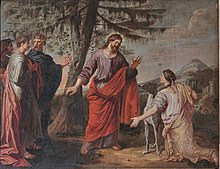Exorcism of the Syrophoenician woman's daughter

The Exorcism of the Syrophoenician woman's daughter is one of the miracles of Jesus and is recounted in the Gospel of Mark in chapter 7 (Mark 7:24–30)[1] and in the Gospel of Matthew in chapter 15 (Matthew 15:21–28).[2] In Matthew, the story is recounted as the healing of a Canaanite woman's daughter.[3] According to both accounts, Jesus exorcised the woman's daughter whilst travelling in the region of Tyre and Sidon, on account of the faith shown by the woman.
The third-century pseudo-Clementine homily refers to her name as Justa and her daughter's name as Berenice.[4]
Passage

The relevant passage in Matthew 15:22–28 reads as follows:
A Canaanite woman from that region came to Jesus, crying out, "Lord, Son of David, have mercy on me! My daughter is demon-possessed and suffering terribly."
Jesus did not answer a word. So his disciples came to him and urged him, "Send her away, for she keeps crying out after us."
He answered, "I was sent only to the lost sheep of Israel".
The woman came and knelt before him. "Lord, help me!" she said.
He replied, "It is not right to take the children's bread and toss it to the dogs".
"Yes Lord," she said. "But even the dogs eat the crumbs that fall from their master's table."
Then Jesus said to her:
"Woman, you have great faith! Your daughter is healed."
And her daughter was healed from that very hour.
Many
This episode is, according to Graham H. Twelftree, an example of how Jesus emphasizes the value of faith, as also shown in the
Syrophoenician woman
The woman described in the miracle, the Syrophoenician woman (Mark 7:26;[7] Συροφοινίκισσα, Syrophoinikissa) is also called a "Canaanite" (Matthew 15:22;[8] Χαναναία, Chananaia) and is an unidentified New Testament woman from the region of Tyre and Sidon. "The woman is [...] described as Syrophoenician by race. It is unclear whether Mark seeks to distinguish between a Phoenician from Syria and one from northern Africa or between someone living in the coastal area of Syria and someone living in the central part."[9]
Although the Gospel of Mark describes the woman as "gentile" or "Greek", the inhabitants of Tyre and Sidon were descendants of the
Commentary
Thomas Aquinas comments on this passage in his homily on the sinful soul, saying,
Five things are noted of this woman of
Chrysostom, the Syrians demonstrated their strong faith by directly bringing their sick to him.[18]Mookgo S. Kgatle describes the Syrophoenician woman as a social activist against traditional Jewish views about gender, purity and ethnicity. However, she accepts the reality of her outsider status when it came to membership in God's chosen people. And whilst Jesus's usage of the word 'dog' can be seen as bigoted, Kgatle argues that 'dog' is not necessarily indicative of anti-gentile sentiment. Ancient Jewish culture used 'dog' to describe enemies of Israel, regardless of background, and also, generic contempt, unworthiness, religious profanity or alternatively, humility. Kgatle notes that the author of the Gospel of Matthew deliberately changed the woman's ethnicity from Syrophoenician to Canaanite to show that she was "unclean and pagan" and the presence of an "Israel-centered conflict" between her and Judeans.[15]
See also
- Ministry of Jesus
- Miracles of Jesus
- Parables of Jesus
- Perfection of Christ
- 1st century in Lebanon
- Asian feminist theology
References
- ^ Mark 7:24–30
- ^ Matthew 15:21–28
- ^
ISBN 0-8308-1596-1pages 133-134- ^ Pseudo-Clementine. . . Also at 3.73 and 4.1.
- ^ Translations available at Biblegateway.com
- ^ Cambridge Bible for Schools and Colleges on Matthew 15, accessed 22 January 2017
- ^ Mark 7:26
- ^ Matthew 15:22
- ^ "Joshua 19:24-31".
- ^ "Judges 1:31-32".
- ^ Lau, Peter H.W. (2009). "Gentile Incorporation into Israel in Ezra - Nehemiah?". Peeters Publishers. 90 (3): 356–373 – via JSTOR.
- ^ a b Kgatle, Mookgo S. (2018). "Crossing boundaries: Social-scientific reading of the faith of a Canaanite woman (Mt 15:21-28)". Stellenbosch Theological Journal. 4 (2) – via Scielo.
- ^ Aquinas, Thomas (1867). . Ninety-nine Homilies of S. Thomas Aquinas Upon the Epistles and Gospels for Forty-nine Sundays of the Christian Year. Church Press Company.
- ^ "Matthew 15 Ellicott's Commentary for English Readers". Biblehub.com. 2024. Archived from the original on February 5, 2024.
- ^
This article incorporates text from this source, which is in the public domain: "Catena Aurea: commentary on the four Gospels; collected out of the works of the Fathers. Oxford: Parker, 1874. Thomas Aquinas". Oxford, Parker. 1874.
Further reading
- Burkill, T. A. "The Historical Development of the Story of the Syrophoenician Woman (Mark vii: 24-31).", Novum Testamentum 9 (1967): 161–177.
- Downing, F. Gerald. "The Woman from Syrophoenicia, and her Doggedness: Mark 7:24-31 (Matthew 15:21-28)." Women in the Biblical Tradition. Ed. George J. Brooke. Lewiston: The Edwin Mellen Press, 1992. 129–149.
- Schäfler, Markus, "The Syrophoenician Woman (Mk 7:24-31)"
- Alt, C., The Dynamic of Humility and Wisdom: The Syrophoenician Woman and Jesus in Mark 7:24-31a, Lumen et Vita, Vol. 2, 2012
- Alonso, P. 2011. The woman who changed Jesus. Crossing Boundaries in Mk 7,24-30. Biblical tools and studies, 11 Archived 2017-01-23 at the Wayback Machine. Peeters Publishers.
External links
Media related to Jesus and the woman of Canaan at Wikimedia Commons

